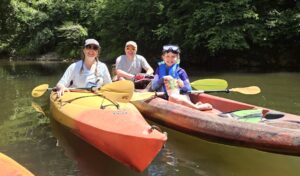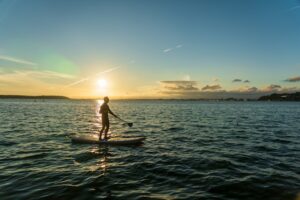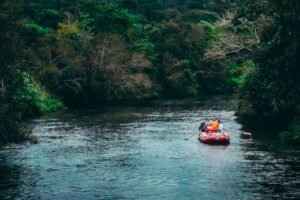With summer now in full swing, families all across Virginia (including my own), will be taking to the water to splash, paddle, float, and enjoy the countless opportunities for outdoor recreation on our rivers.

Attorney David Irvine and family enjoying Virginia’s waterways
Taking in the natural world from the perspective of a canoe or kayak can be equal parts serene and exhilarating. But it is never without risk. Please keep in mind these basic safety precautions to be sure that your day on the water isn’t soured by an injury or other mishap.
River activities
There is no shortage of ways to enjoy a river trip this summer. Here are just a few of the classics:
- Canoeing
- Kayaking
- Stand-up Paddleboarding (“SUP”)
- Tubing
- Rafting
- Fishing
Many areas have dedicated river outfitters that can provide boats, paddles, personal flotation (PFDs), as well as the ever-important shuttle service between the put-in and take-out points. Or, pick up your own gear from a local outdoor store, and enhance the adventure with a do-it-yourself trip!

Virginia rivers
No matter where you live in Virginia, you are not far from a river with fantastic recreation opportunities. Some of my favorites, in no particular order, are:
- Rivanna River: Just down the road from Allen & Allen’s Charlottesville office, the Rivanna River tumbles out of the mountains of Shenandoah National Park. It then flows through Charlottesville until it reaches the James River at Columbia. In recent years, the outfitter Rivanna River Company, founded by Allen & Allen Hometown Heroes Gabe and Sonya Silver, has offered expanded river access to the community.
- Potomac River: The fourth-largest river on the East Coast, the Potomac winds 405 miles from the Potomac Highlands of West Virginia to the Chesapeake Bay. I recommend white water rafting opportunities in the Harper’s Ferry area.
- Maury River: The Maury is unique in that it both begins and ends in one county – my hometown of Rockbridge County. This is the home of the famous Goshen Pass, a scenic whitewater stretch that can challenge even experienced paddlers.
- New River: Winding through the Blue Ridge Highlands of southwestern Virginia, the New River has the distinction of being one of the five oldest rivers in the world. By contrast, the New River Gorge National Park in neighboring West Virginia is one of the newest in the National Park system.
- James River: This iconic river forms in Botetourt County, tumbles over the Blue Ridge Mountains, and flows through Lynchburg, Richmond, Hampton Roads, and into the Chesapeake Bay. It is rich with both Virginia history and recreational opportunities.
Safety Precautions
- Have a plan
First and foremost, have a plan. Research the waterway before departing, including the rapid classifications that you will encounter. Be familiar with both your put-in and take-out locations. Know how long the trip is expected to last, and be mindful of any hidden hazards or dams. Travel with a buddy, and tell someone not coming on your trip where you are going, when you expect to return, and where to call if you do not.
Watch the weather! Summer thunderstorms can pop up quickly, and you do not want to be on the water when there is lightning in the area. Always stay off the river in swift water conditions. If there has been recent rain and the water looks fast and muddy, save your trip for another day. Currents are more powerful than they look and can easily knock you down and sweep you downstream.
- Wear your life jacket
In Virginia, all boaters (including paddlers in canoes, kayaks, or SUPs) are required to carry at least one Coast Guard-approved Type I, II, or III life jacket when operating on a waterway. Children 13-years-old and younger are required to wear their life jacket at all times while underway.
Be familiar with the feel of a properly-fitted life jacket. It should be snug, but not tight. Lift your arms over your head; you should be able to turn your head left, right and over your shoulder without the jacket riding up and interfering. Try it in the water – the life jacket should be snug enough to not ride up over the chin or ears.
It is also best practice to wear a helmet, as well as river shoes to protect your feet from rocks or other sharp objects which may lurk in the riverbed.

- Types of hazards
Low-head dams are deceptively dangerous, because even a relatively small drop-off can create water conditions as dangerous as a large drop. Water flowing over the dam creates a hydraulic at the base which can trap a person and push them underwater. Always know whether there is a dam along your intended route. When on the water, watch for a smooth horizon where the stream meets the sky, as well as concrete retaining walls. All of these can indicate the presence of a dam. Always portage around dams.
Another type of danger is the strainer, a naturally-formed or man-made object which allows water to pass through, but “catches” larger objects, pinning them in place. Trees, rebar, sewer grates, and bushes are all examples. Paddle or portage around this feature whenever possible. If you find yourself outside of your vessel being swept toward a strainer, make every effort to scramble on top of it, so as not to get caught in the water.
- In the event of a mishap
Know what to do in the event that you fall out or your boat capsizes. If you find yourself in fast-moving water, do not try to stand up. The force of the water will push you over and hold you under. Instead, lay on your back with your feet pointing downstream and toes pointing up, and allow the current to carry you to calmer water. Keep an eye out for hazards downstream; most drownings result from getting a leg or ankle caught in rocks or debris on the river floor.
- Water quality issues
Remember that bacteria levels in our rivers can at times increase enough to make you sick or to cause cuts to become infected. Generally speaking, if you plan to swim on your river trip, avoid doing so for a few days after a heavy rain event. Also avoid shallow, warm and/or muddy water. After your trip, always shower with soap and clean water.
Keeping these safety tips in mind will help prevent injuries and mishaps. Should you find yourself in high water and in need of an experienced attorney, please call 866-388-1307. We hope that you have a fantastic time on your Virginia river adventure this summer!


